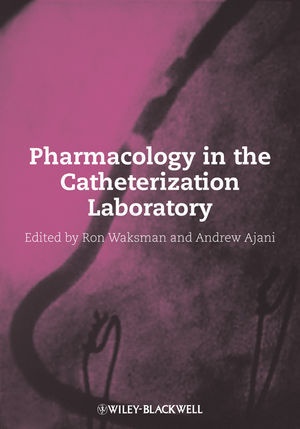Read more
Cardiologists today prescribe medications with complex mechanisms of action, pharmacokinetics, indications, contraindications and drug-frug interactions; many of which were not available when today s practitioners were in training. This book was written to meet the growing demand for complete, detailed and accurate cardiac pharmacology information.
This in-depth examination of the specific types of pharmacological agents used in the cardiac catheterization lab - as well as those routinely prescribed for cardiac patients - evaluates drugs with respect to their:
Cellular and physiological actions
Prescribed usage
Dosages
Adverse reactions
Cautions
Common routes of administration
Opening chapters discuss anticoagulation therapies and antiplatelet therapies. later chapters cover percutaneous coronary intervention and its possible complications, post-procedure pharmacotherapy, and anticoagulation anomalies.
Drawing on the expertise of contributors from around the world, Pharmacology in the Catheterization Laboratory is the perfect blend of evidence and experience.
List of contents
Ron Waksman, Andrew E. Ajani.
0.0 Elective PCI.
0.1 Optimal antithrombotic therapy.
0.1.1 Unfractionated heparin and ACT monitoring.
0.1.2 Alternative to unfractionated heparin.
0.1.2.1 LMWH.
0.1.2.2 direct thrombin inhibitor (bivarlirudin).
0.1.2.3 direct Xa antagonist (fondaparinux).
0.2 Optimal antiplatelet therapy.
0.2.1 Dual aspirin and thienopyridine therapy.
- pre-treatment and dose.
0.2.2 When to use GP2B3A inhibitor and which one to use.
- abciximab, tirofiban, eptifibatide.
0.2.3 Duration of Antiplatelet therapy with drug-eluting vs. bare-metal stents.
1.0 High risk PCI.
1.1 ACS (non ST elevation).
1.1.1 Upstream GP2B3A inhibitors.
1.1.2 Timing, loading dose and duration of clopidogrel therapy.
1.2 Diabetes mellitus.
1.2.1 Peri-procedural management.
1.3 Renal dysfunction.
1.3.1 Renal protective agents.
- IV hydration, N-acetylcysteine, bicarbonate, fenoldopam.
- Timing, route of administration and duration.
1.3.2 Radiocontrast induced nephropathy.
1.3.2.1 Ideal contrast agent.
1.3.3 Additional risk with other medications.
- ACE inhibitors, NSAIDS, hypotensive medications (e.g. nitrates, BBlockers).
1.4 Cardiogenic shock.
1.4.1 Inotropic support.
- adrenaline, noradrenaline, dopamine, dobutamine, milrinone, levosimendan, metaraminol.
- summary of when to use which agent (ref. ACC/AHA STEMI guidelines).
1.4.2 Anticoagulation support for mechanical devices.
- IABP, LVAD, Tandem Heart, Impaler etc.
2.0 Acute STEMI PCI.
2.1 Primary.
- summary of optimal anticoagulation, GP2B3A, antiplatelet therapy (aspirin, clopidogrel).
2.2 Rescue.
- summary of optimal anticoagulation, GP2B3A, antiplatelet therapy (aspirin, clopidogrel).
2.3 Facilitated.
- summary of optimal anticoagulation, GP2B3A and lytic combinations in recent trials.
2.4 Adjunctive therapies.
2.4.1 GIK (glucose-insulin-potassium).
2.4.2 Complement inhibitor (Pexiluzimab).
2.4.3 Intracoronary vs. intravenous GP2B3A inhibitor.
2.4.4 High dose tirofiban.
(Standard dose GP2B3A inhibitors for STEMI discussed in 2.1 and 2.2).
3.0 Optimal thrombolytic therapy (as primary therapy for STEMI).
- alteplase, reteplase, streptokinase, or tenecteplase.
4.0 Special considerations in PCI.
4.1 Coronary spasm.
4.2 No reflow phenomenon.
- IV GTN, GP2B3A inhibitor, nitroprusside, adenosine, verapamil, nicorandil.
4.3 Agents to optimise access of radial artery approach (i.e. nitrates, verapamil).
4.4 Arrhythmia Management.
4.4.1 Tachyarrhythmias management.
- IV lignocaine, amiodarone, etc.
4.4.2 Bradyarrhythmias management.
- IV atropine, adrenalin, indications for temporary pacing wire.
4.5 Coronary perforations.
4.5.1 Reversal of anticoagulation.
- protamine.
4.5.2 Platelet and transfusion of blood products.
4.6 Oral anticoagulation issues in PCI.
4.6.1 Management of patients on anticoagulation undergoing diagnostic catheterisation and PCI.
- prosthetic heart valves, AF and other indications.
- use of UFH and LMWH as bridging therapy.
- when to restart oral anticoagulation post procedure.
4.6.2 Indications for anticoagulation post PCI.
- LV thrombus.
- large anterior myocardial infarction.
About the author
Ron Waksman, MD, FACC. Associate Director, Division of Cardiology, Washington Hospital Center (WHC) and Director of Experimental Angioplasty & Emerging Technologies, Cardiovascular Research Institute(CRI) at WHC, Washington, DC USA.
Andrew E. Ajani, Australia.
Summary
Cardiologists today prescribe medications with complex mechanisms of action, pharmacokinetics, indications, contraindications and drug-frug interactions; many of which were not available when today's practitioners were in training. This book was written to meet the growing demand for complete, detailed and accurate cardiac pharmacology information.

